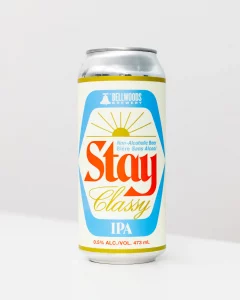 Non-Alcoholic Beer
Non-Alcoholic Beer
Low alcoholic brews have been around for centuries, and can be traced back at least to medieval Europe, where beer was commonly brewed with an alcoholic strength falling between 0.5% to 2.8%. This low alcohol beer, or small beer, was often produced as fortifying beverage for labourers and farmhands.
Non-alcoholic beer has a more specific origin, dating back to 1919 when United States Congress passed the Volstead Act, banning the production and sale of alcoholic beverages. This now-defunct law, still serves as basis for alcohol-free brews in North America today, where a drink containing up to 0.5% ABV (alcohol by volume) is still considered non-alcoholic.
Brewing Non-Alcoholic Beer
There are two methods of producing non-alcoholic beer: reducing alcohol production or removing alcohol post fermentation. Inhibiting alcohol production can be achieved through limited or arrested fermentation. Using limited fermentation, brewers add fewer fermentable sugars, preventing yeast from feasting on sugars and producing high amounts of alcohol.
Arrested fermentation, similarly reduces alcohol production by minimizing yeast activity. This process differs in that yeast is deactivated by cooling fermenting beer down to near freezing temperatures. Through limited and arrested fermentation, the resulting non-alcoholic brew may be slightly sweet, as yeast is prevented from fermenting all of the sugars in wort (the sugary solution of grain extract that is converted by yeast into beer).
The second method of producing non-alcoholic beer is achieved post-fermentation through dealcoholization. Popular techniques include vacuum distillation, membrane filtration and reverse osmosis.
Vacuum Distillation
Heating beer can negatively impact both flavour and body of the beer, to alleviate this effect, some brewers will opt for vacuum distillation. While alcohol’s original boiling point is approximately 78°C., the vacuum reduces it significantly to 34°C. In this method, the alcohol is evaporated out of the mixture at a point when the beer reaches a fairly warm temperature, allowing it to keep more of its flavours intact. Esters that require a higher activation temperature can be recaptured and added back into the dealcoholized brew.
Membrane Filtration
For this process, a finished full-strength beer is strained through a membrane that separates water from alcohol, colour, and some flavour/aroma compounds. The water is removed from the beer and the alcohol is distilled off, before adding the water back to the brew.
Reverse Osmosis
Similar to membrane filtration, reverse osmosis also involves the beer passing through a semipermeable membrane under high-pressure conditions. The main difference is that the filter has a smaller pore size, allowing the larger molecules responsible for the beer’s flavour and aroma to remain in the concentrate.
The majority of non-alcoholic beer is made using the same ingredients and methods as a traditional brew, before undergoing the additional process of dealcoholization. This means that a non-alcoholic beer is often more expensive to brew than full-strength beer, and may have a higher price tag too.
With the non-alcoholic market on the rise, there’s a great selection of locally brewed alcohol-free alternatives, and the options are only getting better.
(Leah is a Toronto based freelance writer as well as Head Beer Weenie and a server at C’est What)

